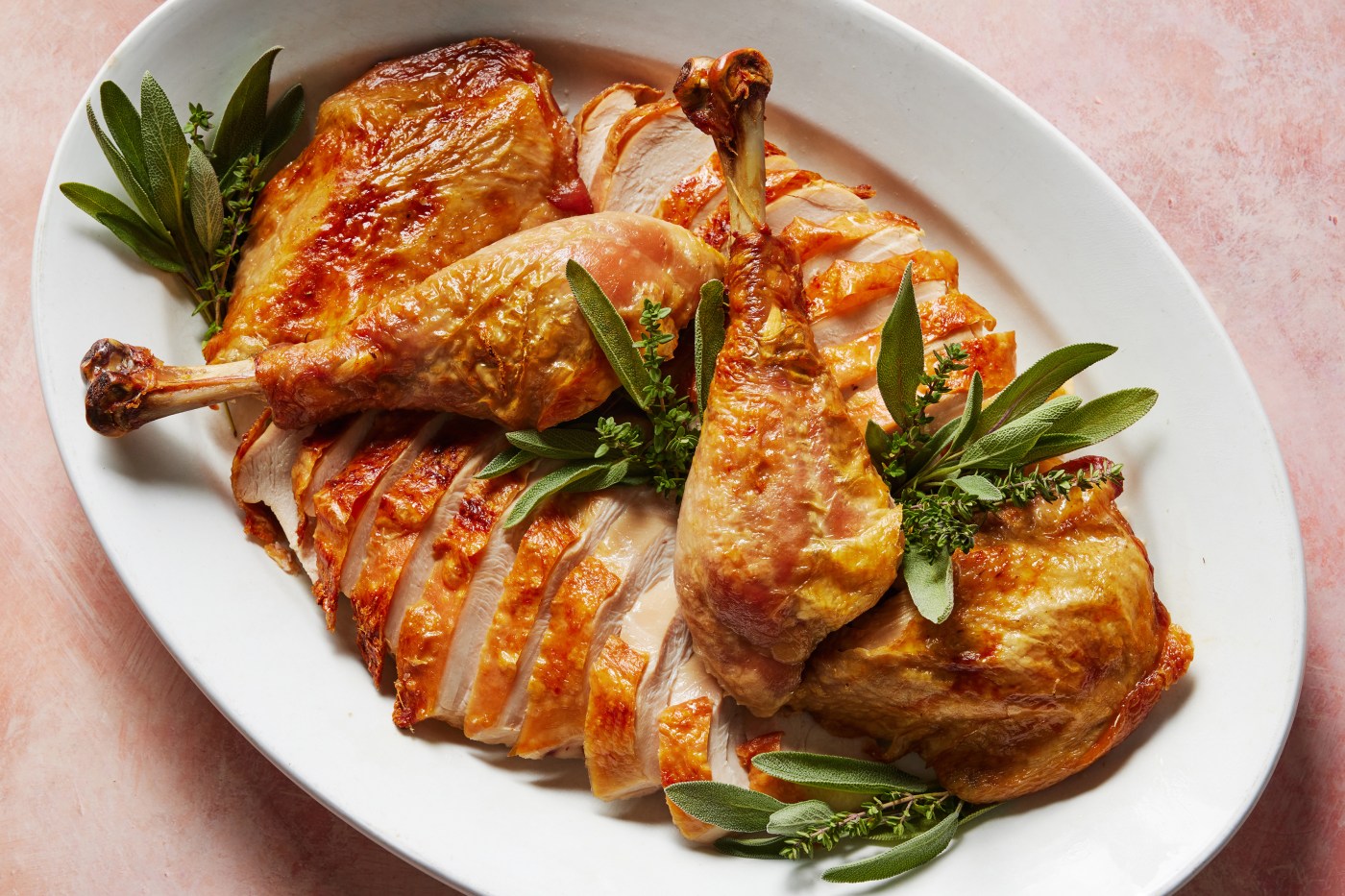
Recipe: A make-ahead turkey that’s ready to travel
In a perfect world, you’d always be able to serve your Thanksgiving turkey directly after its sojourn in the oven. It’s the best way to take advantage of the bird’s crisp juiciness and meaty aroma — not to mention a chance to hide in the kitchen from football games.
But what if you have to drive your cooked turkey an hour away to a Friendsgiving? Or you need room in your oven for pie? Or you’d simply prefer to wake up on Thursday morning secure in the knowledge that the trickiest part of your feast is already waiting for you in the fridge?
Whatever the reason, there are times when you need a killer make-ahead turkey recipe, and I’ve found the way.
It took several weeks of testing and a dozen birds to get the result I wanted: a reheated turkey that tastes very nearly as good as it did right after roasting, with a juicy breast, tender dark meat and glistening, crispy skin.
It also had to be food safe — because Thanksgiving is stressful enough without the added worry of making anyone sick.
The safety advice for reheating turkey comes down to making sure to never leave turkey — neither raw, nor roasted and cooled — unrefrigerated for more than two hours. Then, when reheating, bring the turkey’s core temperature back up to 165 degrees.
The puzzle I had to solve was not only how to do this without drying out the breast or making everything soggy, but also how to make it truly delicious.
Troubleshooting Tricky Meat
Most of the make-ahead recipes I’ve seen call for roasting a whole turkey, letting it cool and cutting it into pieces before chilling. This is convenient for serving because the meat is already carved. But it also intensifies the usual problems of roasting a whole turkey, where cooking the dark meat through can mean drying out the breast meat. Even if you succeed in the first roasting, it’s almost impossible to replicate when you reheat. Breast meat seems to want to dry out.
A common fix is to reheat the white meat in a pan of gravy or broth, or to steam it covered with foil. But the moist environment can turn the meat simultaneously tough and soggy, and the skin limp and slippery.
The first tweak I tried was leaving the breast whole while reheating it. While this improved the texture slightly, it wasn’t enough to make the breast delicious, and the skin stayed just as unappealing.
Then again, since the turkey was just going to get cut up after roasting, why not cut it all up beforehand and roast it in pieces? Theoretically, this gives you more control, since you can take the breast pieces out of the oven just as they’re done, while the legs finish cooking to perfection.
That technique worked nicely for the initial roasting: It’s terrific if you’re not trying to re-create a Norman Rockwell painting. But once reheated, the breast meat was exactly as tough and soggy as before, whether I reheated it still on the bone or carved off in one piece.
(The dark meat came out great, however — something to keep in mind if your crowd wouldn’t be averse to a panful of flawlessly roasted turkey thighs and drumsticks without the breasts.)
In the end, the breakthrough turned out to be spatchcocking.
Make-ahead roast turkey. This spatchcocked bird — roasted at a high temperature a few days before, then cooked low and slow before serving — is notable for its crispy skin and tender meat. Food styled by Maggie Ruggiero. (Bobbi Lin/The New York Times)
Spatchcocking is one of my favorite ways to prepare any roast bird, whether an adorable 3-pound chicken or hulking 13-pound turkey. The flat shape facilitates even cooking, and because all of the skin is now draped over the meat and exposed to the oven’s heat, it crisps up gloriously. Spatchcocked birds also cook quickly, in half the time or less compared with a traditional roast. You can have your butcher spatchcock the turkey for you, so you don’t have to struggle with sawing through thick, sturdy turkey bones.
How to Reheat
The best way to reheat a spatchcocked turkey happens to be the easiest — whole and on the bone, without any added liquid in the pan. The skin and fat protect the breast and preserve juiciness, while the skin also re-crisps nicely. And the legs end up just as tender and succulent as when they were freshly roasted.
It takes the same amount of time to reheat a spatchcocked turkey as it does to roast in the first place, 45 minutes to an hour. This is partly because of the lower temperature. Because while you need to blast the raw bird with high heat in a 450-degree oven, you reheat more gently, at 350 degrees. As a bonus, the low-and-slow reheating allows you to bake (or reheat) your sides, like stuffing or sweet potato casserole, in the oven at the same time.
Perhaps the greatest de-stressor here is that there’s no guesswork left about when the bird is finally done. When it’s steaming hot and the skin is glistening, your turkey will be ready for the table — wherever that may be.
Recipe: Make-Ahead Roast Turkey
By Melissa Clark
Roasting a spatchcocked turkey in a very hot oven, then reheating at a more moderate temperature is the key to success in this make-ahead recipe. The spatchcocked turkey fares far better than a whole bird when reheated. Its flat shape reheats evenly so the breast doesn’t dry out, and it’s easier to fit into both your oven and fridge. And since you reheat at a convenient 350 degrees, you might be able to reheat or bake other dishes in the oven at the same time. Note that it does take about as long to reheat the bird as it does to roast it in the first place (at 450 degrees), which is something to consider if you have flexibility on Thanksgiving Day.
Yield: 12 servings
Total time: 2 hours, 10 minutes, plus at least 2 days for brining, cooling and chilling
INGREDIENTS
1 (11- to 13-pound) turkey, thawed if frozen, spatchcocked
3 to 4 tablespoons kosher salt (such as Diamond Crystal)
2 bunches fresh rosemary, sage or thyme, or a combination
Olive oil, for drizzling
DIRECTIONS
Place a flat wire rack on top of a large rimmed baking sheet. Place the turkey on top of the rack.
Pat turkey dry with paper towels. Rub turkey all over with 3 to 4 tablespoons of salt (1/2 teaspoon salt per pound). Refrigerate uncovered overnight or for up to 3 days.
Remove turkey from the refrigerator 1 hour before roasting and allow to come to room temperature.
Meanwhile, place oven rack toward the bottom third of the oven and heat oven to 450 degrees.
Using about half the herbs, tuck some sprigs under the turkey. Drizzle turkey lightly with oil (you can use a pastry brush or your hands to help spread it evenly if you like). Roast until an instant-read thermometer inserted in the thickest part of the thigh reads 165 degrees, 40 to 55 minutes. If the breast looks like it’s getting too brown before the legs are done, cover it with foil.
Remove turkey from the oven and let it cool completely. Remove herbs and cover with foil or plastic and refrigerate for up to 3 days.
To reheat, remove turkey from the refrigerator 1 to 2 hours (but no longer) before roasting to allow it to come to room temperature.
Heat oven to 350 degrees. Tuck more herbs around the turkey.
Roast until an instant-read thermometer inserted in the thickest part of the thigh reads 165 degrees, 45 to 60 minutes.
Let turkey rest for 15 minutes before carving.
Tips for Success
• As with any roasted turkey, dry-brining a few days ahead helps season the bird and gives a golden, crisp skin. You can use just salt and pepper, or add herbs, spices and citrus zest if you like. Or use your favorite dry brine recipe.
• If the pre-roasted, cooled bird will be out of the refrigerator for more than two hours, pack it in a cooler so it stays cold.
• After taking it out of the fridge, let the pre-roasted bird come to room temperature for one to two hours before reheating. And note: You don’t need to rest this turkey after reheating.
• If you want to reheat the stuffing and sweet potatoes and the like at the same time as the turkey, put the bird on upper rack of the oven and the vegetables below.
• Lining the bottom of the roasting pan with fresh herbs (rosemary, thyme and sage) when reheating adds flavor to the bird and adds a fantastic aroma to the kitchen.
• This reheating technique works with any spatchcock turkey recipe. If you have a favorite, go ahead and use it.
— This article originally appeared in the New York Times.
Related Articles
Recipe: Make Thanksgiving dinner rolls the King Arthur Baking Co. way
Recipe: Whole roasted turkey with giblet gravy, from Butterball
Facing a Thanksgiving baking emergency? Call this hotline
Recipe: The Pie Hole’s Moe’s Pumpkin Pie
Recipe: Spiced Brown Sugar-Pecan Coffee Cake is a sweet indulgence for the holidays


